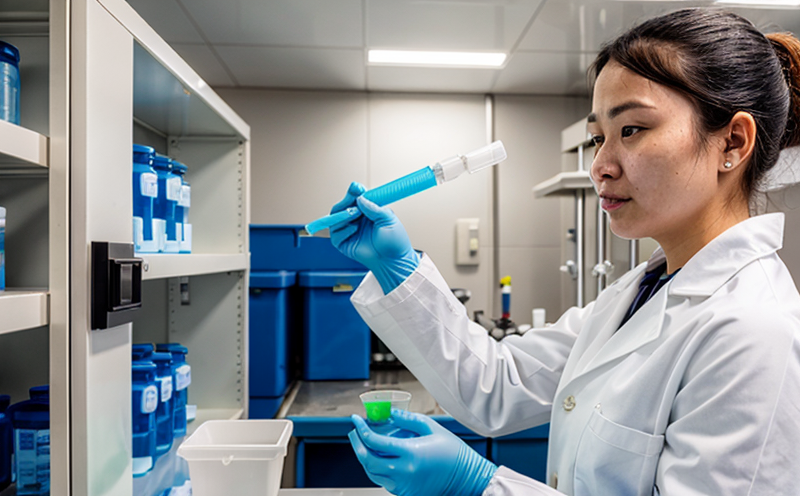USP Mycobacteria Detection Testing
The USP Mycobacteria Detection Test is a critical procedure in pharmaceutical manufacturing, designed to ensure that drug products and excipients are free from contamination by pathogenic mycobacteria. Pathogenic mycobacteria such as Mycobacterium tuberculosis can pose significant health risks if present in pharmaceuticals, leading to recalls, product failures, and potential legal issues.
This test is particularly important for products that come into direct contact with the body, including injectables, ointments, and inhalants. The presence of mycobacteria can cause severe infections and complications, especially in immunocompromised patients. Therefore, pharmaceutical manufacturers are required to adhere strictly to USP General Chapter <1120>, which mandates the detection and control of mycobacteria.
The process involves a series of steps that ensure accurate detection and identification of mycobacteria. Initially, samples are collected from production environments or finished products. These samples are then processed using selective media to isolate and cultivate any potential mycobacterial contaminants. The isolation step is crucial as it helps in identifying the presence of mycobacteria without interference from other microorganisms.
The cultivation process typically takes several weeks due to the slow growth rate of mycobacteria. Once colonies suspected to be mycobacteria are identified, they undergo a series of confirmatory tests such as biochemical reactions and DNA sequencing to ensure accurate identification. This detailed approach ensures that only true pathogenic species are reported.
For pharmaceutical manufacturers, this test not only aids in maintaining product quality but also plays a vital role in safeguarding public health. The results from the USP Mycobacteria Detection Test are essential for compliance with regulatory bodies such as the FDA and EMA, ensuring that products meet stringent safety standards before being released to the market.
The importance of this test cannot be overstated, especially given the increasing awareness about contamination risks in pharmaceuticals. By adhering to this procedure, manufacturers can ensure that their products are safe for use and comply with international guidelines.
| Standard | Description |
|---|---|
| USP <1120> | Mandatory test for the detection and control of mycobacteria in pharmaceuticals. |
| ISO 14698-3 | Guidelines for microbiological testing in cleanroom environments. |
| EN ISO 22517 | Standard for the detection of mycobacteria in pharmaceutical products. |
The implementation and maintenance of this test require expertise in microbiology, strict adherence to laboratory protocols, and state-of-the-art facilities. Compliance officers and quality managers should ensure that all personnel involved in the testing process are well-trained and up-to-date with the latest procedures and standards.
Why It Matters
The USP Mycobacteria Detection Testing is not just a formality; it's an essential safeguard for public health. The presence of mycobacteria in pharmaceutical products can lead to severe infections, particularly in immunocompromised patients. This highlights the critical need for this test as part of the quality assurance process.
From a manufacturing perspective, failing to conduct these tests can result in product recalls and potential legal actions. These repercussions not only damage the reputation of the company but also incur significant financial losses. Therefore, it is imperative that pharmaceutical manufacturers invest in robust testing protocols to prevent such issues from arising.
The regulatory landscape surrounding mycobacteria contamination is stringent. Compliance with standards like USP <1120> ensures that products meet the highest safety and efficacy standards set by regulatory bodies worldwide. This compliance not only protects consumers but also enhances brand reputation and trust in the market.
In summary, the significance of the USP Mycobacteria Detection Testing lies in its role as a preventive measure against mycobacterial contamination. By adhering to these tests, pharmaceutical manufacturers can ensure product safety, maintain regulatory compliance, and protect public health.
Applied Standards
| Standard | Description |
|---|---|
| USP <1120> | Mandatory test for the detection and control of mycobacteria in pharmaceuticals. |
| ISO 14698-3 | Guidelines for microbiological testing in cleanroom environments. |
| EN ISO 22517 | Standard for the detection of mycobacteria in pharmaceutical products. |
| ASTM E2694 | Test method for isolation and identification of mycobacteria from pharmaceutical samples. |
| IEC 60578-1 | Standard for microbiological testing in medical devices. |
| EN ISO 22519 | Guidelines for the control of mycobacteria in pharmaceutical manufacturing environments.|
| AAMI T48 | Guidelines for microbial contamination control in healthcare settings. |
The application of these standards ensures a comprehensive approach to detecting and controlling mycobacteria. This holistic method helps manufacturers identify potential risks early on, allowing them to take corrective actions promptly. By adhering to these guidelines, pharmaceutical companies can maintain high-quality standards in their manufacturing processes.
Benefits
The USP Mycobacteria Detection Testing offers numerous benefits to pharmaceutical manufacturers. Primarily, it ensures product safety by detecting and eliminating potential contaminants before they reach the market. This proactive approach helps in preventing recalls, which can be costly and damaging to a company's reputation.
In addition to safeguarding public health, this testing also enhances brand reputation. Consumers are increasingly aware of the risks associated with pharmaceutical contamination, and companies that prioritize safety earn greater trust from their customers. This trust translates into long-term customer loyalty and market share growth.
From a regulatory perspective, compliance with USP <1120> ensures that products meet stringent quality standards set by the FDA, EMA, and other global regulatory bodies. This compliance not only reduces the risk of non-compliance penalties but also facilitates easier market access in different regions.
Furthermore, this testing supports continuous improvement within manufacturing processes. By regularly conducting these tests, manufacturers can identify areas for improvement and implement best practices that enhance overall product quality. This ongoing process ensures that pharmaceuticals remain safe and effective over time.
In conclusion, the benefits of USP Mycobacteria Detection Testing extend beyond mere compliance; they contribute to a safer environment for consumers, improved brand reputation, enhanced regulatory compliance, and continuous improvement in manufacturing processes.





